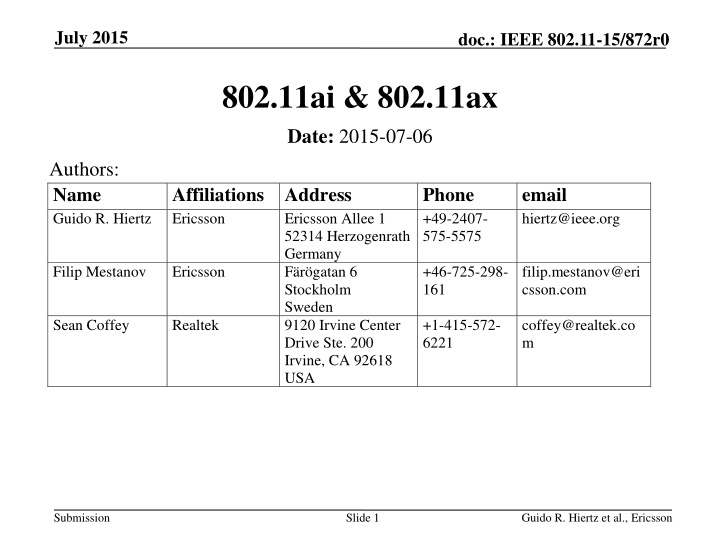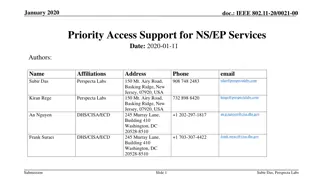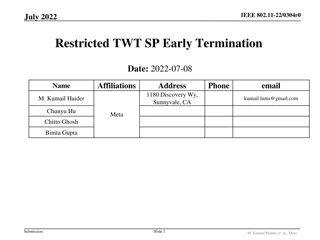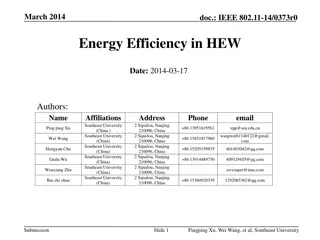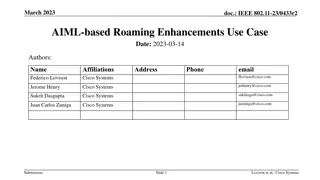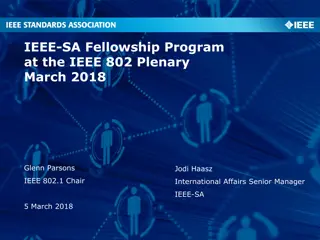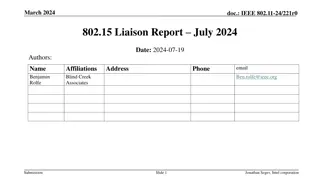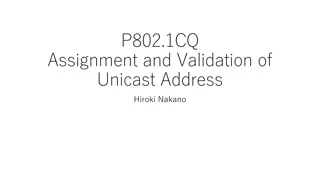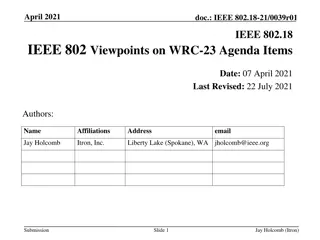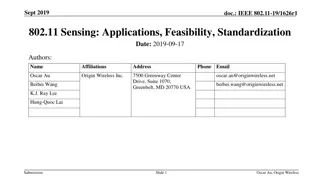IEEE 802.11 Standard Enhancements for Airtime Efficiency
Introduction of IEEE 802.11ax aims to improve average throughput in dense deployment scenarios, addressing issues like probe frame traffic. The integration of 802.11ai with 802.11ax offers solutions to reduce probe frame traffic, enhancing medium usage efficiency and airtime optimization. Various advancements such as FILS and passive scanning techniques play a crucial role in mitigating airtime wastage caused by excessive probe traffic.
Download Presentation

Please find below an Image/Link to download the presentation.
The content on the website is provided AS IS for your information and personal use only. It may not be sold, licensed, or shared on other websites without obtaining consent from the author.If you encounter any issues during the download, it is possible that the publisher has removed the file from their server.
You are allowed to download the files provided on this website for personal or commercial use, subject to the condition that they are used lawfully. All files are the property of their respective owners.
The content on the website is provided AS IS for your information and personal use only. It may not be sold, licensed, or shared on other websites without obtaining consent from the author.
E N D
Presentation Transcript
July 2015 doc.: IEEE 802.11-15/872r0 802.11ai & 802.11ax Date: 2015-07-06 Authors: Name Guido R. Hiertz Affiliations Address Ericsson Phone +49-2407- 575-5575 email hiertz@ieee.org Ericsson Allee 1 52314 Herzogenrath Germany F r gatan 6 Stockholm Sweden 9120 Irvine Center Drive Ste. 200 Irvine, CA 92618 USA Filip Mestanov Ericsson +46-725-298- 161 filip.mestanov@eri csson.com Sean Coffey Realtek +1-415-572- 6221 coffey@realtek.co m Submission Slide 1 Guido R. Hiertz et al., Ericsson
July 2015 doc.: IEEE 802.11-15/872r0 Abstract 802.11ax will introduce improvement in the average throughput per station [ ] in a dense deployment scenario In dense deployments, management traffic becomes a severe issue Several submissions revealed a high amount probe frame traffic 802.11ai provides means to reduce probe frame traffic We propose to adopt 802.11ai with 802.11ax Submission Slide 2 Guido R. Hiertz et al., Ericsson
July 2015 doc.: IEEE 802.11-15/872r0 Probe frame traffic Today, way more probe traffic than assumed in 802.11- 1999 OFDMA, UL MU- MIMO etc. make medium usage more efficient, but don t solve airtime waste Efficiency gains do not compensate for loss in airtime Many submissions to SG HEW and TGax identify excessive probe frame traffic See [1] Probe frame traffic can be severe airtime killer Submission Slide 3 Guido R. Hiertz et al., Ericsson
July 2015 doc.: IEEE 802.11-15/872r0 Probe frame sniffing Fast Initial Link Setup (FILS) tackles several probe storm related problems Probe frames contain publicly available information However, with current implementations devices independently ask for information Multitude of probe frame request/response transmissions 802.11ai [2] allows for overhearing other stations probe responses Prevent stations from transmitting probe frames Uses information that is anyway on the wireless medium Submission Slide 4 Guido R. Hiertz et al., Ericsson
July 2015 doc.: IEEE 802.11-15/872r0 FILS discovery frames 802.11 default beacon transmission interval is 102.4 ms Passive scanning requires stations to wait for beacon reception Can be time consuming with many channels Most implementations use active scanning Station sends out probe request frame to learn about neighborhood Can clog the wireless medium FILS discovery frames are much shorter than beacon frames Consume much less airtime Always transmitted at data rates 6 Mb/s Default FILS discovery frame repetition rate is 20.48 ms Passive scanning becomes attractive FILS discovery frames can substantially reduce the use of active scanning Less probe frames Submission Slide 5 Guido R. Hiertz et al., Ericsson
July 2015 doc.: IEEE 802.11-15/872r0 STRAW POLL Submission Slide 6 Guido R. Hiertz et al., Ericsson
July 2015 doc.: IEEE 802.11-15/872r0 Straw Poll 1 Do you agree to add the following to the IEEE 802.11 TGax Specification Framework? Add to the end of Clause 6 (MAC): The amendment shall define a HE STA to be a FILS STA. Submission Slide 7 Guido R. Hiertz et al., Ericsson
July 2015 doc.: IEEE 802.11-15/872r0 Transform successful straw poll into a motion MOTION Submission Slide 8 Guido R. Hiertz et al., Ericsson
July 2015 doc.: IEEE 802.11-15/872r0 Motion Moved to add to the end of Clause 6 (MAC) of the IEEE 802.11 TGax Specification Framework: The amendment shall define a HE STA to be a FILS STA. Moved by: Seconded: Submission Slide 9 Guido R. Hiertz et al., Ericsson
July 2015 doc.: IEEE 802.11-15/872r0 References 1. K. Yunoki et al., Understanding Current Situation of Public Wi-Fi Usage - Possible Requirements for HEW, 11-13/523 2. IEEE 802.11, IEEE P802.11ai/D5.0, June 2015 Submission Slide 10 Guido R. Hiertz et al., Ericsson
